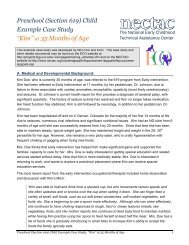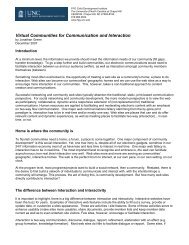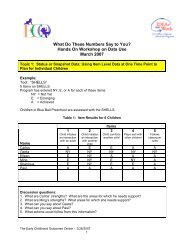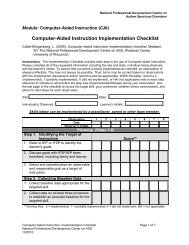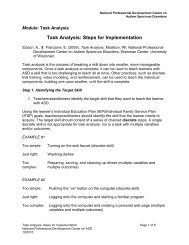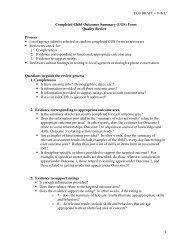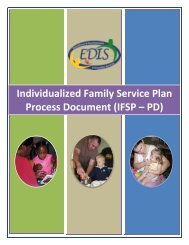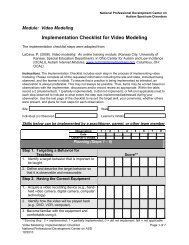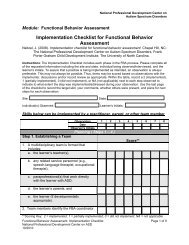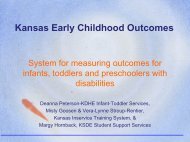FCT Implementation Checklist - National Professional Development ...
FCT Implementation Checklist - National Professional Development ...
FCT Implementation Checklist - National Professional Development ...
You also want an ePaper? Increase the reach of your titles
YUMPU automatically turns print PDFs into web optimized ePapers that Google loves.
<strong>National</strong> <strong>Professional</strong> <strong>Development</strong> Center onAutism Spectrum DisordersModule: Functional Communication Training (<strong>FCT</strong>)<strong>Implementation</strong> <strong>Checklist</strong> for Functional CommunicationTraining (<strong>FCT</strong>)Franzone, E. (2009). <strong>Implementation</strong> checklist for functional communication training (<strong>FCT</strong>).Madison, WI: The <strong>National</strong> <strong>Professional</strong> <strong>Development</strong> Center on Autism SpectrumDisorders, Waisman Center, University of Wisconsin.Instructions: The <strong>Implementation</strong> <strong>Checklist</strong> includes each step in the process of implementing <strong>FCT</strong>.Please complete all of the requested information including the site and state, individual beingobserved/interviewed, and the learner’s initials. To assure that a practice is being implemented asintended, an observation is always preferable. This may not always be possible. Thus, items may bescored based on observations with the implementer, discussions and/or record review as appropriate.Within the table, record a 2 (implemented), 1 (partially implemented), 0 (did not implement), or NA (notapplicable) next to each step observed to indicate to what extent the step was implemented/addressedduring your observation. Use the last page of the checklist to record the target skill, your comments,whether others were present, and plans for next steps for each observation.Site: ________________________________________ State: _________________________________Individual(s) Observed: ________________________ Learner’s Initials: ________________________Skills below can be implemented by a practitioner, parent, or other team memberObservation 1 2 3 4 5 6 7 8DateObserver’s InitialsPlanning (Steps 1 - 6 )Step 1. Identifying the InterferingBehaviorScore**1. Identify an interfering behavior or a subtlecommunicative form to be the interferingbehavior.Step 2. Completing a Functional BehaviorAssessment (FBA)1. Complete a high-quality FBA that includes:a. indirect assessment (e.g., interviews,record reviews, questionnaires) andb. direct assessment (e.g., A-B-Cobservation).2. Identify the function of the interferingbehavior.**Scoring Key: 2 = implemented; 1 = partially implemented; 0 = did not implement; NA = not applicableFunctional Communication Training: <strong>Implementation</strong> <strong>Checklist</strong> Page 1 of 7<strong>National</strong> <strong>Professional</strong> <strong>Development</strong> Center on ASD10/2010
<strong>National</strong> <strong>Professional</strong> <strong>Development</strong> Center onAutism Spectrum DisordersModule: Functional Communication Training (<strong>FCT</strong>)Observation 1 2 3 4 5 6 7 8DateObserver’s InitialsStep 3. Identifying a ReplacementBehavior as a Substitute forInterfering BehaviorScore**1. Select a form of communication that isappropriate to the learner (e.g., signing,verbalizations, pictures).2. Choose a replacement behavior that:a. can be taught in a short amount of timeandb. allows the learner to quickly learn thebehavior and gain access to thereinforcement.3. Identify a replacement behavior that isacceptable and appropriate for theenvironment and the learner.4. Choose a replacement behavior that isrecognized by multiple communicativepartners.5. Incorporate attention-getting into thereplacement behavior, if necessary (e.g., whenusing sign language).Step 4. Designing <strong>Implementation</strong> DataCollection Procedures1. Implement data collection procedures that arefunctional, meaningful, and available to teammembers responsible for data collection.2. Data are collected:a. before <strong>FCT</strong> is implemented (typicallyduring the FBA process) andb. during the implementation of <strong>FCT</strong> (e.g.,weekly).**Scoring Key: 2 = implemented; 1 = partially implemented; 0 = did not implement; NA = not applicableFunctional Communication Training: <strong>Implementation</strong> <strong>Checklist</strong> Page 2 of 7<strong>National</strong> <strong>Professional</strong> <strong>Development</strong> Center on ASD10/2010
<strong>National</strong> <strong>Professional</strong> <strong>Development</strong> Center onAutism Spectrum DisordersModule: Functional Communication Training (<strong>FCT</strong>)Observer’s InitialsStep 4. Designing <strong>Implementation</strong> DataCollection Procedures (cont.)3. Data collection focuses on:a. antecedents,b. prompts required by learner to producethe replacement behavior,c. frequency of the replacement behavior,d. frequency of the interfering behavior, ande. consequences of thereplacement/interfering behavior (i.e.,what happens right after thereplacement/interfering behavior).4. Use data to monitor <strong>FCT</strong> effectiveness andwhether aspects of <strong>FCT</strong> need adjustment.Step 5. Manipulating the Environment toElicit the Interfering Behavior1. Teach the replacement behavior in theenvironments where the interfering behavioroccurs.2. Manipulate materials or activities to provideopportunities for repeated practice of thereplacement behavior.Step 6. Planning Opportunities forGeneralization1. Teach the replacement behavior(s) withmultiple communication partners.2. Teach the replacement behavior(s) acrossmultiple environments.Observation 1 2 3 4 5 6 7 8DateScore**3. Train communicative partners to respond tothe learner’s use of the replacement behavior.**Scoring Key: 2 = implemented; 1 = partially implemented; 0 = did not implement; NA = not applicableFunctional Communication Training: <strong>Implementation</strong> <strong>Checklist</strong> Page 3 of 7<strong>National</strong> <strong>Professional</strong> <strong>Development</strong> Center on ASD10/2010
<strong>National</strong> <strong>Professional</strong> <strong>Development</strong> Center onAutism Spectrum DisordersModule: Functional Communication Training (<strong>FCT</strong>)Step 6. Planning Opportunities forGeneralization (cont.)4. Introduce varied vocabulary for requesting, ifappropriate for learner’s developmental level.Intervention ( Step 7 – 12)Step 7. Prompting Learners to UseReplacement Behavior(s)1. Prompt the learner to use the replacementbehavior, beginning with a prompt thatensures errorless learning.Step 8. Not Reinforcing the InterferingBehavior1. Do not reinforce any instance of theinterfering behavior, if possible.2. Intervene as minimally as possible if theinterfering behavior is potentially dangerous.3. For subtle communicative acts, make theinterfering behavior less efficient than thereplacement behavior by:a. pausing after the learner uses the subtlecommunicative act,.b. asking, “What do you want?”c. prompting the learner to use thereplacement behavior, andd. providing reinforcement for using thereplacement behavior.Step 9. Providing Reinforcement1. All communicative partners consistentlyprovide immediate reinforcement in responseto the replacement behavior.Observation 1 2 3 4 5 6 7 8DateObserver’s InitialsScore**Step 10. Shaping the Response1. Initially accept any approximation of thereplacement behavior.**Scoring Key: 2 = implemented; 1 = partially implemented; 0 = did not implement; NA = not applicableFunctional Communication Training: <strong>Implementation</strong> <strong>Checklist</strong> Page 4 of 7<strong>National</strong> <strong>Professional</strong> <strong>Development</strong> Center on ASD10/2010
<strong>National</strong> <strong>Professional</strong> <strong>Development</strong> Center onAutism Spectrum DisordersModule: Functional Communication Training (<strong>FCT</strong>)Observation 1 2 3 4 5 6 7 8DateObserver’s InitialsProgress Monitoring (Step 11)Step 11. Monitoring Learner Progress1. Collect progress monitoring data for individuallearners to determine:a. learners’ use of communicative acts indifferent settings, andb. the type and intensity of prompts neededby learners to use communicative actscorrectly.2. Use progress monitoring data to determinenext steps.Score****Scoring Key: 2 = implemented; 1 = partially implemented; 0 = did not implement; NA = not applicableFunctional Communication Training: <strong>Implementation</strong> <strong>Checklist</strong> Page 5 of 7<strong>National</strong> <strong>Professional</strong> <strong>Development</strong> Center on ASD10/2010
<strong>National</strong> <strong>Professional</strong> <strong>Development</strong> Center onAutism Spectrum DisordersModule: Functional Communication Training (<strong>FCT</strong>)DateObserverInitialsTarget Skill/Behavior, Comments, and Plans for Next StepsDateObserverInitialsTarget Skill/Behavior, Comments, and Plans for Next StepsDateObserverInitialsTarget Skill/Behavior, Comments, and Plans for Next StepsDateObserverInitialsTarget Skill/Behavior, Comments, and Plans for Next StepsFunctional Communication Training: <strong>Implementation</strong> <strong>Checklist</strong> Page 6 of 7<strong>National</strong> <strong>Professional</strong> <strong>Development</strong> Center on ASD10/2010
<strong>National</strong> <strong>Professional</strong> <strong>Development</strong> Center onAutism Spectrum DisordersModule: Functional Communication Training (<strong>FCT</strong>)DateObserverInitialsTarget Skill/Behavior, Comments, and Plans for Next StepsDateObserverInitialsTarget Skill/Behavior, Comments, and Plans for Next StepsDateObserverInitialsTarget Skill/Behavior, Comments, and Plans for Next StepsDateObserverInitialsTarget Skill/Behavior, Comments, and Plans for Next StepsFunctional Communication Training: <strong>Implementation</strong> <strong>Checklist</strong> Page 7 of 7<strong>National</strong> <strong>Professional</strong> <strong>Development</strong> Center on ASD10/2010



